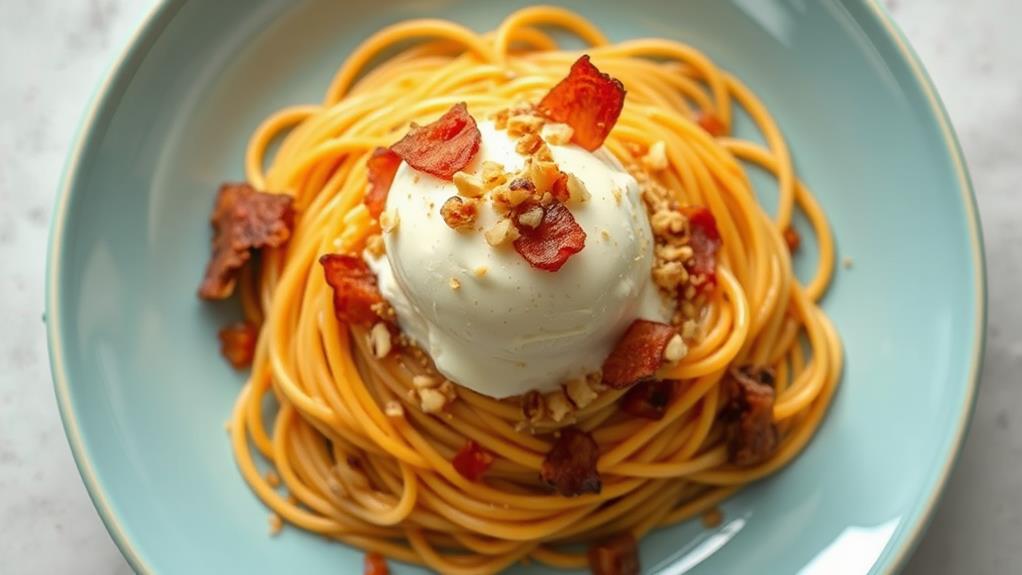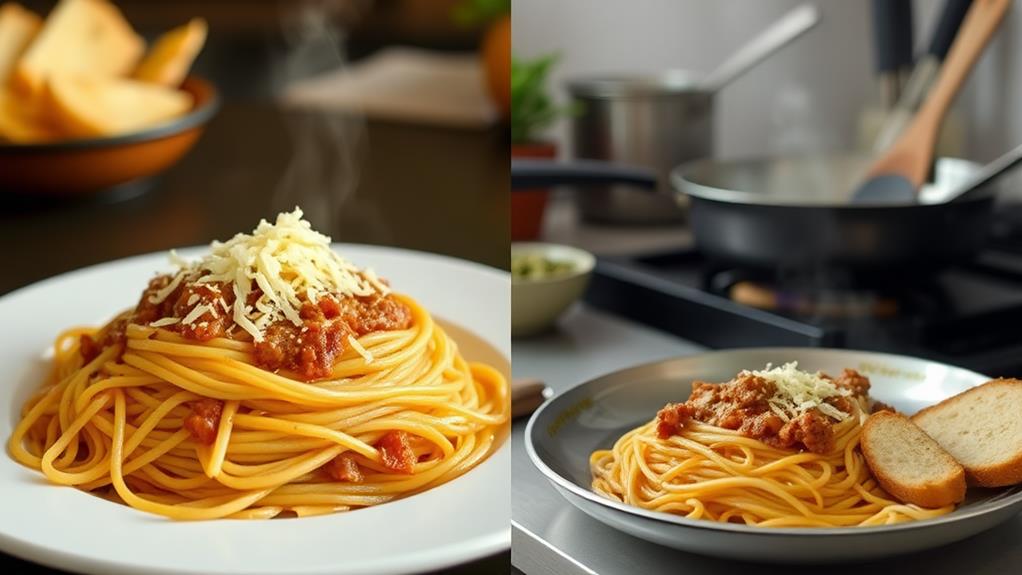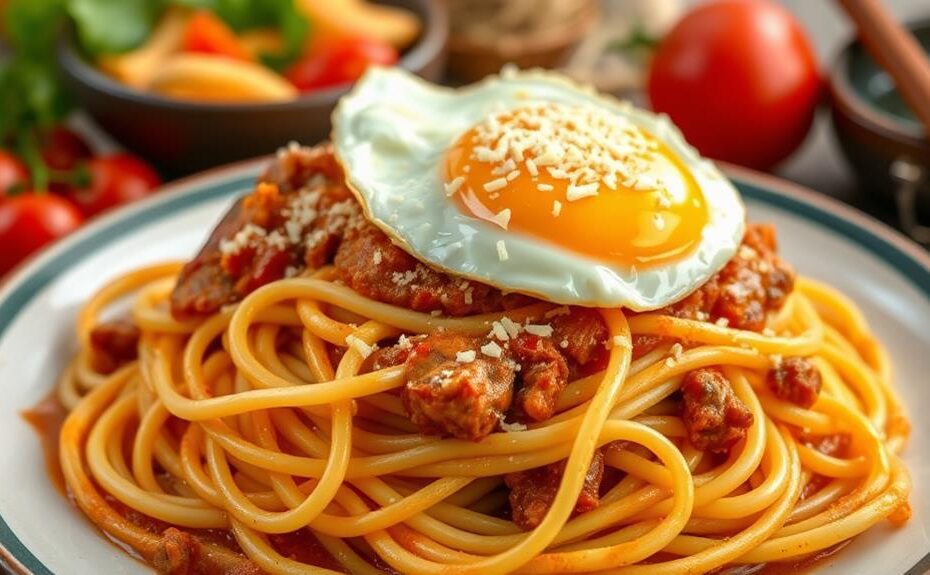Essential Ingredients for Filipino-Style Spaghetti
To create an authentic Filipino-style spaghetti, you need sweet tomato sauce, ground beef or hot dogs, and quick-melting cheese.
Pair with Complementary Dishes
Pair your spaghetti with fried chicken and garlic bread for a complete meal experience.
Get Creative with Pairings
Consider pairing your spaghetti with sweet and savory dishes like macaroni salad and lumpia (Filipino spring rolls) to balance the flavors and textures.
Cultural Significance
Filipino spaghetti is more than just a meal; it's a cultural celebration that brings people together.
Final Tips
Remember to balance the flavors and textures with complementary dishes and refreshing beverages when finalizing your dish.
Filipino Spaghetti Essentials

Filipino Spaghetti Essentials
The Foundation: Sweet Tomato Sauce and Banana Ketchup
Filipino spaghetti relies on a sweet tomato sauce, which is often elevated by the addition of banana ketchup. This unique combination creates a distinct flavor profile that sets Filipino spaghetti apart.
Protein Powerhouse: Ground Beef and Hot Dogs
Ground beef is a classic protein choice for Filipino spaghetti, but sliced hot dogs are a popular and flavorful alternative. Hot dogs add a salty, meaty flavor that complements the sweet tomato sauce.
The Perfect Topping: Quick-Melting Cheese
Quick-melting cheese is the ideal topping for Filipino spaghetti. Its velvety texture and mild flavor balance the sweetness of the tomato sauce and the savory flavor of the hot dogs.
A Cultural Significance
Filipino spaghetti is more than just a dish; it's an integral part of Filipino celebrations, often served alongside fried chicken and garlic bread at kids' birthday parties and special gatherings.
Cooking Filipino Style Spaghetti
Cooking Filipino Style Spaghetti
To prepare Filipino-style spaghetti, start by cooking the spaghetti noodles according to the package instructions. Do not overcook them, as the perfect al dente texture is essential.
While the noodles are cooking, prepare the sweet tomato sauce.
Preparing the Sweet Tomato Sauce
For the sweet tomato sauce, use ground beef or a combination of proteins such as ground pork, sliced hotdogs, and luncheon meat.
Sauté the proteins with garlic and onions until they're browned, then add the sweet tomato sauce and a dash of banana ketchup for the distinct Filipino flavor.
Let the sauce simmer until it thickens and becomes rich.
Assembling the Dish
Once the noodles are cooked, combine them with the prepared sweet tomato sauce.
Top the dish with shredded quick-melt cheese to complete the Filipino spaghetti. This dish is sure to be a hit at your next family gathering.
Sweet and Savory Pairings

Elevate Your Filipino Spaghetti with These Sweet and Savory Pairings
Filipino Style Spaghetti, with its sweet tomato-based sauce, is a perfect match for savory fried chicken, creating a classic Filipino party dish combination.
The sweetness of the sauce is balanced by the crispy, savory flavors of the fried chicken. Traditionally, the dish is topped with grated quick melt cheese, which adds a creamy texture that complements the sweetness of the sauce.
Add a Refreshing Twist with Macaroni Salad
Serving Filipino Spaghetti alongside macaroni salad provides a delightful contrast of flavors and textures.
The creamy and tangy profile of the salad balances the rich flavors of the spaghetti. This combination offers a refreshing twist on the traditional dish.
Add Crunch with Lumpia
For a more savory touch, consider adding lumpia (Filipino spring rolls) as a side dish.
The crispy texture of the lumpia contrasts nicely with the soft spaghetti, providing a satisfying combination.
Complete the Meal with a Refreshing Beverage
Sweetened iced tea or a light fruit punch harmonize with the dish's sweetness while providing a refreshing beverage option.
These flavorful pairings will transport you to a classic Filipino fiesta!
Nutrition and Serving Sizes
Filipino Style Spaghetti is a well-balanced meal option that provides a mix of flavors, textures, and nutrients.
A 1-cup serving of Filipino Style Spaghetti contains approximately 534 calories. This serving size provides a balanced nutritional profile, consisting of 66g of carbohydrates, 24g of protein, and 20g of fat.
Additionally, it's a good source of essential vitamins like Vitamin A and Vitamin C.
To maintain a balanced caloric intake, it's essential to practice portion control.
Dividing your meal into smaller servings can help you manage your calorie consumption throughout the day. Pairing your spaghetti with a side of vegetables or a salad can also enhance your nutrient intake while controlling calorie consumption.
Cultural Significance and History

Filipino spaghetti is a cultural staple that evokes nostalgia and comfort. This dish is a staple of Filipino heritage, reminiscent of happy times and warm connections with family and friends at birthday parties and family gatherings.
The dish's origins date back to American colonization in the late 1800s. During this period, hot dogs and ketchup were introduced to local cuisine.
Filipinos' sweet tooth led to the creation of banana ketchup, a key ingredient in the signature sweet tomato-based sauce of Filipino spaghetti.
The rise of Jollibee Spaghetti further solidified the dish's cultural significance. The vibrant red color of the dish is more than just visually appealing – it symbolizes deliciousness and celebration in Filipino culture.
Recipe Variations and Adaptations
Filipino Spaghetti Variations
Filipino spaghetti offers a wide range of variations, allowing you to customize the dish to your taste preferences.
Meat Lover's Variation
Adding beef hot dogs and diced ham creates a hearty and savory flavor profile.
Creamy Delight Variation
Incorporating evaporated milk and cream cheese results in a rich and indulgent flavor experience.
Veggie Bonanza Variation
The addition of bell peppers, carrots, and mushrooms adds freshness and nutritional value to the dish.
Savory Twist Variation
Using soy sauce and fish sauce creates a balanced and umami flavor profile.
Experimenting with Cheese
Try using different cheeses, such as mozzarella or a blend of quick-melt and cheddar, to create a unique topping that enhances the dish's richness.
The key to creating a signature Filipino spaghetti recipe is finding the perfect balance between sweet and savory flavors.
Cooking Techniques and Tips

Mastering Cooking Techniques for Filipino Spaghetti
To perfect your Filipino spaghetti, focus on refining your cooking techniques to bring out the best flavors.
Cooking Spaghetti Noodles
Cook spaghetti noodles to an al dente texture to prevent mushy noodles from ruining your dish. This texture ensures the noodles retain some firmness in the center.
Sautéing Onions and Garlic
Sauté onions and garlic in oil until they're soft and fragrant. This step brings out the natural sweetness of the onions and garlic, adding depth to your sauce.
Cooking Ground Beef and Adding Filipino Flavors
Cook ground beef until it's fully browned, then add sliced hotdogs and luncheon meat to incorporate the signature Filipino flavors.
Let the mixture simmer for at least 30 minutes to develop rich flavors.
Balancing Acidity with Milk
To balance the acidity of the tomato-based sauce, add a splash of evaporated milk or condensed milk for a creamy, sweet twist.
Finishing Touches
When serving, top your Filipino spaghetti with shredded quick-melt cheese for a creamy, melty finish. This combination appeals to both kids and adults alike.
What are Different Ways to Serve Filipino Style Spaghetti?
Filipino style spaghetti can be served in various ways to suit different tastes. Some popular spaghetti pinoy variations include adding hotdogs, ham, and ground meat to the sauce. Others prefer to top it off with cheese, or even add a touch of sweetness with banana ketchup or condensed milk.
Storing and Reheating Leftovers
Proper Storage for Leftover Filipino Spaghetti
To keep your leftover Filipino spaghetti fresh, store it in airtight containers, separating the meat sauce and noodles to prevent mushiness. This way, you can refrigerate it for up to 3 days.
Freezing for Long-Term Storage
If you want to extend the shelf life of your leftover spaghetti, freeze the meat sauce and noodles separately. When stored properly, they can last up to 2 months.
Reheating Frozen Spaghetti
To reheat frozen spaghetti, submerge the sealed container in boiling water until warm.
Alternatively, you can heat the sauce in a pan and mix it with freshly cooked noodles.
Reheating Refrigerated Leftovers
When reheating refrigerated leftovers, add a splash of water or broth to the sauce to maintain moisture and prevent it from drying out.
Reheating Tips
Avoid microwaving the spaghetti directly, as this can lead to uneven heating and affect the texture of the noodles.
Frequently Asked Questions
What Is Different About Filipino Style Spaghetti?
Filipino style spaghetti is a unique variation of traditional spaghetti. It combines sweet and savory Filipino flavors with conventional pasta.
The dish typically includes hotdogs and luncheon meat mixed with ground pork, which sets it apart from other pasta dishes.
Filipino spaghetti holds cultural significance. It's often served at festive occasions and family gatherings, reflecting the local adaptations and taste preferences that make Filipino cuisine distinct.
What Is the Best Way to Serve Spaghetti?
Serving Spaghetti with Flair
When serving spaghetti, proper plating techniques are essential. Position the noodles in a neat, curved shape on the plate, allowing the sauce to coat them evenly. Add a generous pour of sauce, ensuring each bite will be flavorful.
Strategically place toppings, such as meatballs or sautéed vegetables, to create visual appeal.
Garnish with Fresh Herbs or Cheese
Add a pop of color and freshness with a sprinkle of parsley or a sprinkle of parmesan cheese. These simple garnishes elevate the dish and add a touch of sophistication.
Serve Hot and in Generous Portions
Serve the spaghetti hot, straight from the kitchen, to preserve the noodles' texture and the sauce's flavor. Offer portion sizes that cater to both kids and adults, ensuring everyone leaves the table satisfied.
Pair with Complementary Side Dishes
Select side dishes that complement the sauce variations, such as garlic bread for meat-based sauces or a green salad for lighter, olive oil-based sauces. This thoughtful pairing enhances the overall dining experience.
Create a Memorable Occasion
Turn a simple spaghetti dinner into a special occasion by inviting family and friends to share the meal together. This creates lasting memories and makes the effort worthwhile.
What Is Filipino Style Spaghetti and Why Is It Named One of the Worst Dishes in the World?
Filipino Style Spaghetti: A Cultural Treasure
Filipino Style Spaghetti is a regional adaptation that combines tomato sauce, banana ketchup, and hotdogs, deviating from traditional spaghetti.
This unique combination is a result of cultural fusion, blending Italian and American influences with local Filipino flavors.
Despite its unorthodox ingredients, Filipino Style Spaghetti holds a special place in Filipino hearts. It evokes childhood memories of family gatherings and festive occasions.
The dish is often served at children's parties and special events, making it a staple in many Filipino households.
Filipino Style Spaghetti has been named one of the "worst dishes in the world", but this criticism hasn't deterred its popularity in the Philippines.
Its cultural significance and nostalgic value outweigh any negative opinions, solidifying its place in Filipino cuisine.
Why Is Filipino Spaghetti Sauce Sweet?
Filipino spaghetti sauce is sweet due to the use of banana ketchup and added sugar. This unique flavor profile is a result of cultural influences and local taste preferences.
In the Philippines, banana ketchup is a common condiment used in place of traditional tomato ketchup. It has a sweeter and thicker consistency than regular ketchup, which contributes to the overall sweetness of the spaghetti sauce.
Additionally, sugar is often added to balance out the acidity of the tomatoes and create a flavor that's appealing to Filipino children. This sweet and savory blend is a distinctive characteristic of Filipino cuisine.
